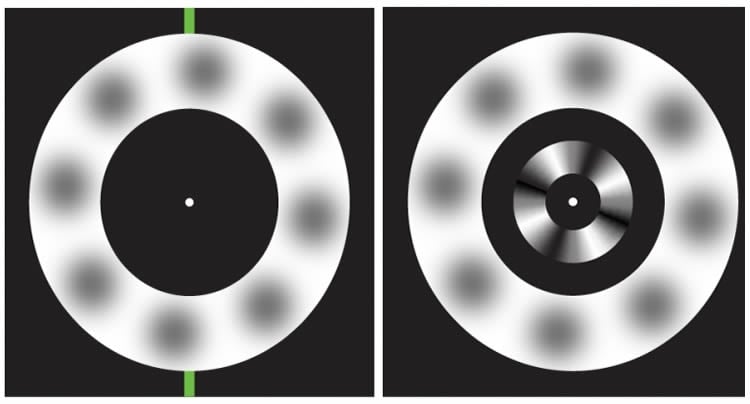Summary: Researchers have developed a new method to induce visual hallucinations in healthy people. The study could help to develop new treatments to control hallucinations in people with Parkinson’s and other disorders.
Source: University of New South Wales.
Breakthrough opens door to study hallucinations scientifically.
A new method for inducing, modelling and measuring visual hallucinations in healthy individuals suggests these complex experiences share a common underlying mechanism with normal visual perception, UNSW researchers say.
Although commonly associated with psychiatric disorders, healthy people can also have visual hallucinations after taking drugs, being sleep deprived or suffering migraines. These involuntary experiences are thought to arise when spontaneous changes in the brain temporarily hijack visual function, but the exact causes and underlying mechanisms aren’t fully understood.
“We have known for more than 100 years that flickering light can cause almost anyone to experience a hallucination,” says UNSW Associate Professor Joel Pearson from the School of Psychology.
“However, the unpredictability, complexity and personal nature of these hallucinations make them difficult to measure scientifically,” he says.
Nobody has been able to do this before, because they haven’t been able to overcome this key challenge.
The content of these visions – including colours and forms that appear and how they move around – are constantly changing over time and are inherently subjective. “Previous studies have typically relied on drawings and verbal descriptions, but these don’t provide us with a way to precisely identify the mechanisms in our brain that cause hallucinations,” says Pearson.

One of the grand challenges in the field has been inducing hallucinations in the lab that are stable and identical for all people. Now, thanks to Pearson and his team, this is possible. It means they can scientifically measure the strength of hallucinations without relying on subjective descriptions.
Using a flickering white light against a black backdrop, the UNSW team was able to induce visual hallucinations in a number of healthy volunteers, causing them to ‘see’ pale grey blobs.
It is recommended that anyone with a history of migraines, epilepsy or psychiatric disorders refrain from watching the video below. You should see pale grey blobs appear in the ring and rotate around it, first in one direction and then the other.
“With our technique we get rid of the unpredictability. People don’t see windmills, lines, or different colours; they just hallucinate grey blobs. Once the hallucination is stable like this, with just the blobs, we can start to objectively investigate the underlying mechanisms,” says Pearson.
“Nobody has been able to do this before, because they haven’t been able to overcome this key challenge.”
Using new techniques, they were able to measure the strength of the hallucinations, and pinpoint that the hallucinations were arising inside the visual cortex – the region of the brain that processes visual information and allows us to see.
“The induced hallucinations also seem to obey many of the same laws and properties as normal visual perception,” says Pearson.
The team’s results are published today in the journal eLife and comes as Australia marks Mental Health Week.
Pearson says the next step is to investigate whether the experimental methods can be used to model hallucinations produced by psychiatric disorders. The team has begun working with people with Parkinson’s disease.
“Not everyone who gets Parkinson’s has hallucinations,” says Pearson. “If we can use these models to study their hallucinations, we can find out what might be causing them, and hopefully learn more about other symptoms that accompany natural hallucinogenic states.”

“It will help inform us about what is happening pathologically in the brain during hallucinations, and ultimately help us develop new treatments.”
“As we mark Mental Health Week, this study highlights the urgent importance of translational science for understanding and developing new treatments for mental health.
“The World Economic Forum has predicted mental health care will cost around six trillion a year by 2030, so we urgently need new methods and laboratory models to understand mental illness,” says Pearson.
Flickering lights and a pale grey blob – how the scientists induced and measured hallucinations
The volunteers were university students with no history of migraines or psychiatric disorders. The students watched an image of a plain white ring flicker on and off up to around 130 times per second against a black background.
All individuals reported seeing pale grey blobs appear in the ring and rotate around it, first in one direction and then the other.
To measure the hallucinations, the team placed a second ring marked with permanent grey blobs inside the white ring. By stating whether the hallucinated blobs were lighter or darker than the real blobs, the participants were able to communicate how strong the hallucination was.
Using behavioural science techniques, the team was able to demonstrate that the hallucinations were arising inside the visual cortex, without the need for MRI scans. They did this by showing volunteers two flickering-lights – one for each eye, displayed out of synchrony.
Hallucination inducing flickering ring – Warning, rapidly flashing images.
These lights were flashing about 2.5 times per second – a relatively slow rate, which normally doesn’t induce strong hallucinations, explains Pearson. But the volunteers were experiencing hallucinations consistent with lights flashing about 5 times per second.
“They were combining the signals from the two eyes. This really only happens in the visual cortex, not in the eye, or other initial processing areas of the brain,” says Pearson.
Working with mathematicians from the University of Pittsburgh, the team developed neural models of the visual cortex to try to understand what was happening. Pearson likens these models to the vibrational phenomena known as cymatics, where sound frequencies can be seen pushing sand grains into geometric patterns.
“Rather than a metal plate and sand, we’re talking about the visual cortex, where we see these reverberating, self-organising patterns of activity. We think this could be how the brain is creating the hallucination, and it might also help to explain normal consciousness, and our experience of what’s happening around us every day.”
Source: Kirsten MacGregor – University of New South Wales
Image Source: NeuroscienceNews.com images are credited to Joel Pearson.
Video Source: The video is credited to Joel Pearson.
Original Research: Full open access research for “Sensory dynamics of visual hallucinations in the normal population” by Joel Pearson, Rocco Chiou, Sebastian Rogers, Marcus Wicken, Stewart Heitmann, and Bard Ermentrout in eLife. Published online October 11 2016 doi:10.7554/eLife.17072
[cbtabs][cbtab title=”MLA”]University of New South Wales “Did You See That? Inducing Visual Hallucinations in Healthy People.” NeuroscienceNews. NeuroscienceNews, 12 October 2016.
<https://neurosciencenews.com/hallucination-psychology-visual-5277/>.[/cbtab][cbtab title=”APA”]University of New South Wales (2016, October 12). Did You See That? Inducing Visual Hallucinations in Healthy People. NeuroscienceNew. Retrieved October 12, 2016 from https://neurosciencenews.com/hallucination-psychology-visual-5277/[/cbtab][cbtab title=”Chicago”]University of New South Wales “Did You See That? Inducing Visual Hallucinations in Healthy People.” https://neurosciencenews.com/hallucination-psychology-visual-5277/ (accessed October 12, 2016).[/cbtab][/cbtabs]
Abstract
Sensory dynamics of visual hallucinations in the normal population
Hallucinations occur in both normal and clinical populations. Due to their unpredictability and complexity, the mechanisms underlying hallucinations remain largely untested. Here we show that visual hallucinations can be induced in the normal population by visual flicker, limited to an annulus that constricts content complexity to simple moving grey blobs, allowing objective mechanistic investigation. Hallucination strength peaked at ~11 Hz flicker and was dependent on cortical processing. Hallucinated motion speed increased with flicker rate, when mapped onto visual cortex it was independent of eccentricity, underwent local sensory adaptation and showed the same bistable and mnemonic dynamics as sensory perception. A neural field model with motion selectivity provides a mechanism for both hallucinations and perception. Our results demonstrate that hallucinations can be studied objectively, and they share multiple mechanisms with sensory perception. We anticipate that this assay will be critical to test theories of human consciousness and clinical models of hallucination.
“Sensory dynamics of visual hallucinations in the normal population” by Joel Pearson, Rocco Chiou, Sebastian Rogers, Marcus Wicken, Stewart Heitmann, and Bard Ermentrout in eLife. Published online October 11 2016 doi:10.7554/eLife.17072






